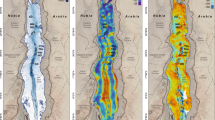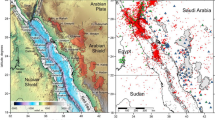Abstract
New investigations of the Southwest Indian and Arctic ridges reveal an ultraslow-spreading class of ocean ridge that is characterized by intermittent volcanism and a lack of transform faults. We find that the mantle beneath such ridges is emplaced continuously to the seafloor over large regions. The differences between ultraslow- and slow-spreading ridges are as great as those between slow- and fast-spreading ridges. The ultraslow-spreading ridges usually form at full spreading rates less than about 12 mm yr-1, though their characteristics are commonly found at rates up to approximately 20 mm yr-1. The ultraslow-spreading ridges consist of linked magmatic and amagmatic accretionary ridge segments. The amagmatic segments are a previously unrecognized class of accretionary plate boundary structure and can assume any orientation, with angles relative to the spreading direction ranging from orthogonal to acute. These amagmatic segments sometimes coexist with magmatic ridge segments for millions of years to form stable plate boundaries, or may displace or be displaced by transforms and magmatic ridge segments as spreading rate, mantle thermal structure and ridge geometry change.
This is a preview of subscription content, access via your institution
Access options
Subscribe to this journal
Receive 51 print issues and online access
$199.00 per year
only $3.90 per issue
Buy this article
- Purchase on Springer Link
- Instant access to full article PDF
Prices may be subject to local taxes which are calculated during checkout





Similar content being viewed by others
References
Solomon, S. in Drilling the Oceanic Lower Crust and Mantle, JOI/USSAC Workshop Report (ed. Dick, H. J. B.) 73–74 (Woods Hole Oceanographic Institution, Woods Hole, MA, 1989)
Small, C. in Faulting and Magmatism at Mid-Ocean Ridges (eds Buck, W., Delaney, P. T., Karson, J. A. & Lagabrielle, Y.) 1–26 (American Geophysical Union, Washington DC, 1998)
Macdonald, K. C. in The Western North Atlantic Region (eds Vogt, P. & Tucholke, B.) 51–68 (Geological Society of America, Boulder, CO, 1986)
Heezen, B. C. The rift in the ocean floor. Sci. Am. 203, 99–106 (1960)
Fornari, D. J., Haymon, R. M., Perfit, M. R. & Edwards, M. H. Geological characteristics and evolution of the axial zone on fast spreading mid-ocean ridges: formation of an axial summit trough along the East Pacific Rise, 9°-10°N 1998. J. Geophys. Res. 103, 9827–9855 (1998)
Small, C. & Sandwell, D. T. An abrupt change in ridge axis gravity with spreading rate. J. Geophys. Res. 94, 17383–17317 (1989)
Cochran, J. R. Systematic variation of axial morphology along the Southeast Indian Ridge. Eos 260, 88 (1991)
Phipps Morgan, J. & Chen, Y. Dependence of ridge-axis morphology on magma supply and spreading rate. Nature 364, 706–708 (1993)
Reid, I. & Jackson, H. R. Oceanic spreading rate and crustal thickness. Mar. Geophys. Res. 5, 165–172 (1981)
Jackson, H. R., Reid, I. & Falconer, R. K. H. Crustal structure near the Arctic mid-ocean ridge. J. Geophys. Res. 87, 1773–1783 (1982)
Bown, J. W. & White, R. S. Variation with spreading rate of oceanic crustal thickness and geochemistry. Earth Planet. Sci. Lett. 121, 435–439 (1994)
White, R. S., Minshull, T. A., Bickle, M. J. & Robinson, C. J. Melt generation at very slow-spreading oceanic ridges: constraints from geochemical and Geophysical data. J. Petrol. 42, 1171–1196 (2001)
Dick, H. J. B., Georgen, J. E., le Roex, A. P., Lin, J. & Madsen, J. A. The influence of ridge geometry on mantle melting at an ultra-slow spreading ridge. Eos F919 (1998)
Georgen, J. E., Lin, J. & Dick, H. J. B. Evidence from gravity anomalies for interactions of the Marion and Bouvet hotspots with the Southwest Indian Ridge: effect of transform offsets. Earth Planet. Sci. Lett. 187, 283–300 (2002)
Cochran, J. R., Kurras, G. J., Edwards, M. H. & Coakley, B. J. The Gakkel Ridge: Bathymetry, gravity anomalies and crustal accretion at extremely slow spreading rates. J. Geophys. Res. 2003, doi:10/1029/2002JB001830 (2002)
Macdonald, K. C., Scheirer, D. S., Carbotte, S. & Fox, P. J. It's only topography: Parts 1 & 2. GSA Today 3, 1–35 (1993)
Kuo, B.-Y. & Forsyth, D. W. Gravity anomalies of the ridge-transform system in the South Atlantic between 31 and 34.5°S: Upwelling centers and variations in crustal thickness. Mar. Geophys. Res. 10, 205–232 (1988)
Lin, J. & Phipps Morgan, J. The spreading rate dependence of three-dimensional mid-ocean ridge gravity structure. Geophys. Res. Lett. 19, 13–16 (1992)
Tolstoy, M., Harding, A. J. & Orcutt, J. A. Crustal thickness on the Mid-Atlantic Ridge: Bull's-eye gravity anomalies and focused accretion. Science 262, 726–729 (1993)
Magde, L. S. & Sparks, D. W. Three-dimensional mantle upwelling, melt generation, and melt migration beneath segment slow spreading ridges. J. Geophys. Res. 102, 20571–20583 (1997)
Dauteuil, O. & Brun, J. P. Oblique rifting in a slow spreading ridge. Nature 361, 145–148 (1993)
Clay, K. R. & White, M. J. Analogue modelling of orthogonal and oblique rifting. Mar. Petrol. Geol. 12, 137–151 (1995)
Jokat, W. et al. Geophysical evidence for reduced melt production on the Arctic ultraslow Gakkel mid-ocean ridge. Nature 423, 962–965 (2003)
Sauter, D. et al. The Southwest Indian Ridge between 49°15′E and 57°E: focused accretion and magma redistribution. Earth Planet. Sci. Lett. 192, 303–317 (2001)
Grindlay, N. R., Madsen, J. A., Rommevaux-Jestin, C. & Sclater, J. A different pattern of ridge segmentation and mantle Bouguer gravity anomalies along the ultra-slow spreading Southwest Indian Ridge (15°30′E to 25°E). Earth Planet. Sci. Lett. 161, 243–253 (1998)
le Roex, A. P., Dick, H. J. B. & Watkins, R. T. Petrogenesis of anomalous K-enriched MORB from the Southwest Indian Ridge: 11°53′E to 14°38′E. Contrib. Mineral. Petrol. 110, 253–268 (1992)
DeMets, C., Gordon, R. G., Argus, D. F. & Stein, S. Current plate motions. Geophys. J. Int. 101, 425–478 (1990)
DeMets, C., Gordon, R. G., Argus, D. F. & Stein, S. Effect of recent revisions to the geomagnetic reversal time scale on estimates of current plate motions. Geophys. Res. Lett. 21, 2191–2194 (1994)
Okino, K. et al. Preliminary analysis of the Knipovich Ridge segmentation: influence of focused magmatism and ridge obliquity on an ultraslow spreading system. Earth Planet. Sci. Lett. 202, 279–288 (2002)
Cochran, J. R. & Coakley, B. J. Morphology and segmentation of the Gakkel Ridge, Arctic Ocean, from SCICEX data. Eos 79, F854 (1998)
Brozena, J. M. et al. New aerogeophysical study of the Eurasia Basin and Lomonosov Ridge: Implications for basin development. Geology 31, 825–828 (2003)
Michael, P. J. et al. Magmatic and amagmatic seafloor generation at the ultraslow-spreading Gakkel Ridge, Arctic Ocean. Nature 423, 956–961 (2003)
Jackson, H. R. & Reid, I. Oceanic magnetic anomaly amplitudes: variation with sea-floor spreading rate and possible implications. Earth Planet. Sci. Lett. 63, 368–378 (1983)
Feden, R. H., Vogt, P. R. & Fleming, H. S. Magnetic and bathymetric evidence for the “Yermak Hot Spot” northwest of Svalbard in the Arctic Basin. Earth Planet. Sci. Lett. 44, 18–38 (1979)
Duckworth, G. L., Baggeroer, A. B. & Jackson, H. R. Crustal structure measurements near FRAMII in the Pole Abyssal Plain. Tectonophysics 89, 172–215 (1982)
Michael, P. J. et al. The Arctic Mid-Ocean Ridge Expedition—AMORE 2001—Seafloor spreading at the top of the world. Eos 82, F1097 (2001)
Edwards, M. H. et al. Evidence of recent volcanic activity on the ultraslow-spreading Gakkel ridge. Nature 409, 808–812 (2001)
Coakley, B. J. & Cochran, J. R. Gravity evidence of very thin crust at the Gakkel Ridge (Arctic Ocean). Earth Planet. Sci. Lett. 162, 81–95 (1998)
Vogt, P., Taylor, P. T., Kovacs, L. C. & Johnson, G. L. Detailed aeromagnetic investigation of the Arctic Basin. J. Geophys. Res. 84, 1071–1089 (1989)
Standish, J., Dick, H., le Roex, A., Melson, W. & O'Hearn, T. Major and trace element geochemistry: Ultra-slow spreading SWIR (9°–25° E). Eos 83,F1331 (2002)
Klein, E. M. & Langmuir, C. H. Global correlations of ocean ridge basalt chemistry with axial depth and crustal thickness. J. Geophys. Res. 92, 8089–8115 (1987)
Salters, V. J. M. & Dick, H. J. B. Mineralogy of the mid-ocean-ridge basalt source from neodymium isotopic composition of abyssal peridotites. Nature 418, 68–72 (2002)
Mahoney, J., Le Roex, A. P., Peng, Z., Fisher, R. L. & Natland, J. H. Southwestern limits of Indian Ocean ridge mantle and the origin of low 206Pb/204Pb mid-ocean ridge basalt: isotope systematics of the Central Southwest Indian Ridge (17°-50°E). J. Geophys. Res. 97, 19771–19790 (1992)
Pertermann, M. & Hirschmann, M. M. Anhydrous partial melting experiments on MORB-like Éclogite: Phase relations, phase compositions and mineral-melt partitioning of major elements at 2–3 GPa. J. Petrol. 44, 2173–2201 (2003)
Dick, H. J. B. & Natland, J. Late stage melt evolution and transport in the shallow mantle beneath the East Pacific Rise. In Scientific Results (eds Gillis, K., Mevel, C. & Allan, J.) 103–134 (Ocean Drilling Program, Texas A&M University, College Station, TX, 1996)
Sandwell, D. T. & Smith, W. H. F. Marine gravity anomaly from Geosat and ERS 1 satellite altimetry. J. Geophys. Res. 102, 10039–10054 (1997)
Poliakov, A. N. B. & Buck W. R. in Faulting and Magmatism at Mid-Ocean Ridges (eds Buck, W. R., Delaney, P. T., Karson, J. A. & Lagabrielle, Y.) 305–324 (American Geophysical Union, Washington DC, 1998)
Phipps Morgan, J., Parmentier, E. M. & Lin, J. Mechanisms for the origin of mid-ocean ridge axial topography; implications for the thermal and mechanical structure of accreting plate boundaries. J. Geophys. Res. 92, 12823–12836 (1987)
Sotin, C. & Parmentier, E. M. Dynamical consequences of compositional and thermal density stratification beneath spreading centers. Geophys. Res. Lett. 16, 368–377 (1989)
Forsyth, D. W. in Mantle Flow and Melt Generation at Mid-Ocean Ridges (eds Phipps Morgan, J., Blackman, D. K. & Sinton, J. M.) 1–66 (American Geophysical Union, Washington DC, 1992)
Macnab, R. & Jakobsson, M. The International bathymetric chart of the Arctic Ocean (IBCAO): An improved morphological framework for oceanographic investigations. Geophys. Res. Abstr. 5, 10909 (2003)
Acknowledgements
The National Science Foundation funded this work. We thank the crew and scientific party of RV Knorr Voyage 162, Legs 7-9 and the AMORE scientific party for discussions, particularly P. Michael, G. Kurras, C. Langmuir, J. Snow and W. Jokat. We also wish to acknowledge J. Standish for coordinating rock description on both cruises. J. P. Morgan, R. Buck, G. Hirth and J. Standish provided reviews of the manuscript, and R. Searle, and J. Cann provided us with additional insights into ridge tectonics.
Author information
Authors and Affiliations
Corresponding author
Ethics declarations
Competing interests
The authors declare that they have no competing financial interests.
Rights and permissions
About this article
Cite this article
Dick, H., Lin, J. & Schouten, H. An ultraslow-spreading class of ocean ridge. Nature 426, 405–412 (2003). https://doi.org/10.1038/nature02128
Received:
Accepted:
Issue Date:
DOI: https://doi.org/10.1038/nature02128
This article is cited by
-
Complete transition from mantle plume to mantle exhumation on the Central Atlantic Guyana/Suriname margin
Communications Earth & Environment (2024)
-
Unfolding rotational tectonics and topographic evolution from localized verses diffuse plate boundary counterparts
Scientific Reports (2024)
-
Oceanic mantle beneath ultraslow spreading ridges metasomatized by variably evolved melts
Contributions to Mineralogy and Petrology (2024)
-
Volcanic evolution of an ultraslow-spreading ridge
Nature Communications (2023)
-
How transform fault shear influences where detachment faults form near mid-ocean ridges
Scientific Reports (2023)
Comments
By submitting a comment you agree to abide by our Terms and Community Guidelines. If you find something abusive or that does not comply with our terms or guidelines please flag it as inappropriate.



